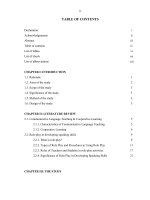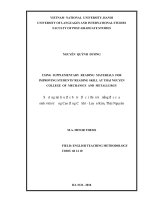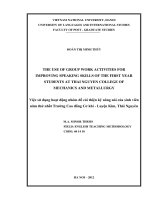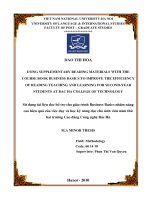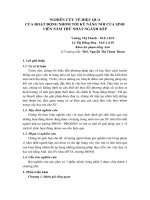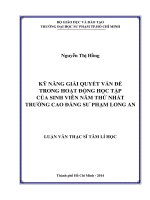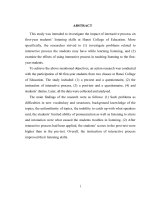Việc sử dụng hoạt động nhóm để cải thiện kỹ năng nói của sinh viên năm thứ nhất Trường Cao đẳng Cơ khí Luyện kim, Thái Nguyên
Bạn đang xem bản rút gọn của tài liệu. Xem và tải ngay bản đầy đủ của tài liệu tại đây (654.52 KB, 58 trang )
VIETNAM NATIONAL UNIVERSITY, HANOI
UNIVERSITY OF LANGUAGES AND INTERNATIONAL STUDIES
FACULTY OF POST - GRADUATE STUDIES
ĐOÀN THỊ MINH THÚY
THE USE OF GROUP WORK ACTIVITIES FOR
IMPROVING SPEAKING SKILLS OF THE FIRST YEAR
STUDENTS AT THAI NGUYEN COLLEGE OF
MECHANICS AND METALLURGY
Việc sử dụng hoạt động nhóm để cải thiện kỹ năng nói của sinh viên
năm thứ nhất Trường Cao đẳng Cơ khí - Luyện Kim, Thái Nguyên
M.A. MINOR THESIS
FIELD: ENGLISH TEACHING METHODOLOGY
CODE: 60 14 10
HA NOI – 2012
VIETNAM NATIONAL UNIVERSITY, HANOI
UNIVERSITY OF LANGUAGES AND INTERNATIONAL STUDIES
FACULTY OF POST - GRADUATE STUDIES
ĐOÀN THỊ MINH THÚY
THE USE OF GROUP WORK ACTIVITIES FOR
IMPROVING SPEAKING SKILLS OF THE FIRST YEAR
STUDENTS AT THAI NGUYEN COLLEGE OF
MECHANICS AND METALLURGY
Việc sử dụng hoạt động nhóm để cải thiện kỹ năng nói của sinh viên
năm thứ nhất Trường Cao đẳng Cơ khí - Luyện Kim, Thái Nguyên
M.A. MINOR THESIS
FIELD: ENGLISH TEACHING METHODOLOGY
CODE: 60 14 10
SUPERVISOR : VĂN THỊ THANH BÌNH, M.Ed
HA NOI – 2012
iv
TABLE OF CONTENTS
Declaration i
Acknowledgements ii
Abstract iii
List of abbreviations iv
List of figures and tables iv
Table of contents v
PART 1: INTRODUCTION 1
1. Rationale of the study 1
2. Aims of the study 2
3. Scope of the study 2
4. Research questions 2
5. Methods of the study 3
6. Design of the study 3
PART 2: DEVELOPMENT 4
Chapter 1: Literature Review 4
1.1. Speaking skill and teaching speaking skill 4
1.1.1. Definitions of speaking 4
1.1.2. Teaching and learning speaking skill 4
1.2. Group work in a speaking lesson 5
1.2.1. Definitions of group work 5
1.2.2. Types of group work 6
1.2.3. The advantages and disadvantages of using group work 7
1.2.3.1. Advantages 7
1.2.3.2. Disadvantages 7
1.2.4. Group size 9
1.2.5. The role of the teacher and the role of each student in 9
group work activities
v
1.2.5.1. The role of the teacher 9
1.2.5.2. The role of each student in group work activities 10
1.2.6. Some common activities for group work 11
1.2.7. How to design group work activities effectively 14
1.2.7.1. Forming students in groups 14
1.2.7.2. Preparing for students to work in group 16
1.2.7.3. Monitoring group work activities 16
1.2.7.4. Ending group work activities 16
1.3. Summary 17
Chapter 2: Research methodology 18
2.1. Design and methodology 18
2.1.1. The setting of the study 18
2.1.2. Data collection instrument 19
2.1.3. The participants 20
2.1.3.1. The teachers 20
2.1.3.2. The students 21
2.2. Preliminary results 21
2.2.1. Student survey 21
2.2.1.1. Students’ opinions on speaking skill 21
2.2.1.2. Students’ opinions on learning speaking skills in group work 22
2.2.1.3. Students’ appreciation of the use of group work in the 23
speaking class
2.2.1.4. Difficulties the students have had when working in group work 25
2.2.1.5. Students’ desire for the better group work 26
2.2.2. Teacher survey 29
2.2.2.1. Teachers’ opinions on teaching speaking skill 29
2.2.2.2. Teachers’ opinions on the use of group work to teaching 29
speaking skill
2.2.2.3. How the teachers use group work in their current speaking class 31
vi
2.2.2.4. Difficulties faced by the teachers when applying group work 34
in the speaking class
2.2.2.5. Teachers’ solutions to overcome their difficulties 36
Chapter 3: Findings and recommendations 37
3.1. Findings 37
3.1.1. How much group work was used 37
3.1.2. Problems in applying group work 38
3.1.2.1. Students’ problems 38
3.1.2.2. Teachers’ problems 39
3.1.2.3. Problems concerning classroom conditions 39
3.2. Recommendations 40
3.2.1. Concerning the students 40
3.2.2. Concerning the teachers 40
3.2.3. For the administrator 41
PART 3: CONCLUSION 42
1. Conclusions 42
2. Limitations of the study 43
3. Suggestions for futher study 43
REFERENCES 45
APPENDICES
Appendix 1: Questionnaire for students I
Appendix 2: Questionnaire for teachers IV
1
LIST OF ABBREVIATIONS
CMM: College of Mechanics and Metallurgy
ESP: English for Special Purposes
ESL: English Foreign Language
CLT: Communicative Language Teaching
M.A : Master Degree
LIST OF CHARTS AND TABLES
Charts
Chart 1: Students’ assessment for the teachers’ frequent use of group work
Chart 2: Student’ appreciation of their participation in group work
Chart 3: The frequency of difficulties
Chart 4: Factors causing difficulties
Chart 5 : Ways students wanted teachers to put them in group
Chart 6: Activities students wished teachers to select for group work
Chart 7: Steps students expect teacher to follow in organizing group work
Chart 8: Ways teacher often used to group students
Chart 9: Activities teachers often selected for group work
Chart 10: Steps teacher followed in organizing group work
Chart 11: Things the teachers often do when the students work in groups
Chart 12: Teachers’ solutions to overcome their obstacles
Tables
Table 1: Students’ opinions on the importance of speaking skill
Table 2: Students’ opinions on learning speaking skills in group work.
Table 3: Students’ appreciation of group work for the benefit of speaking skill
Table 4: Teachers’ opinion on teaching speaking skill
Table 5: Teachers’ opinions on the use of group work to teaching speaking skill
Table 6: The ways teachers prepared and the stages teachers used for group work
Table 7: Difficulties faced by the teachers when applying group work in the
speaking class
2
PART 1: INTRODUCTION
1. Rationale for the study
Today, English has become an international language. It is spoken as a second
language and an official language in many countries, and millions of people speak
English as a foreign language. Besides, English is considered the medium of
communication in many fields such as science, technology, aviation, internet,
commerce, and so on. Therefore learning and teaching English are getting more and
more important to non-native nations of English, Vietnam is not an exception.
In Vietnam, English has been used more and more widely, and it has become the
most popular foreign language in the country. Thus, people have a great concern
about learning English. As a result, English is a compulsory subject at schools and
colleges, and the number of ordinary people learning English nowadays is also on
the rise.
To keep pace with the demand of English usage in our society, learners'
communicative competence as well as learner-centered learning are the prefered of
approaches to foreign language teaching today. However, for a long time, the
teaching of English at The College of Mechanics and Mettalurgy (CMM) was
performed with traditional teaching methods. Much attention is paid to grammatical
competence whereas other aspects of language learning such as communicative
competence do not receive enough attention. As a result, though their goal of
learning a foreign language is to communicate in that language, many Vietnamese
students still find it challenging when talking to, not to mention communicating
successfully with English speaking people.
As a teacher of English at CMM, I am aware of the importance of helping students
become communicators of English, and one of the most effective ways that I have
to used to enhance my students' speaking ability is to use group work activities in
teaching. It is my observation that these activities created more chances for students
3
to communicate with one another in the medium of English. Morever, students
often appeared less anxious when they worked in groups.
For the above reason, the topic of the use of group work activities for improving
speaking skills of the first year students at CMM was chosen for this thesis in the
hope to study whether group work really help students improve their spoken
English.
2. Aims of the study
The study is aimed at investigating to clarify how group work is used in the
speaking class of the 1
st
year students at CMM. To be specific, the objectives of the
study are :
- To clarify students’ opinions of the use of group work activities in the speaking class.
- To find the factors that influence the teachers in their application of group work in
the speaking class of the 1
st
year students at CMM.
- To suggest practical recommendations for the possibility of group work in the
speaking class of the 1
st
year students at CMM.
3. Scope of the study
To improve speaking skill of the 1
st
year students at CMM, the researcher intends to
investigate the current situation of using group work in the speaking class of the 1
st
year students at CMM and then making some suggestions for improvement it. The
study was carried out with the participation of 70 first-year students and 8 teachers
of English.
4. Research questions
This study is implemented to find answers to the following research questions:
1. What do the students think of the use of group work activities in the speaking
class of the first year students at CMM?
2. What facilitates and hinders the teachers from using group work in the speaking
class at CMM ?
3. What suggestions for improvement should be used to make group work activities
successful in speaking class of the first year students at CMM?
4
5. Methods of the study
In order to examine the situation of the study, this research used questionnaires. The data
collected from the questionnaires (both for students and teachers), will be analyzed and
generalized.
6. Design of the study
The study has three main parts as follows:
Part 1: Introduction
This part introduces the rationale, the aims, the scope and the design of the study.
Part 2: Development
This part consists of three chapters:
Chapter 1: Literature review
Chapter 2: Research methodology
Chapter 3: Findings and recommendations
Part 3: Conclusion
This part summaries all the major findings and suggestions. The limitations of the
study and recommendations for the further studies are also include in this part.
5
PART 2: DEVELOPMENT
CHAPTER 1: LITERATURE REVIEW
1.1. Speaking skill and teaching speaking skill
1.1.1 Definitions of speaking
There are various definitions of speaking and the popular acceptance comes from
Jones, R (1989:86) who defines speaking as “Speaking is a form of communication,
so it is important that what you say conveyed in the most effective way.” Speaking
is one of the basic skills that must be mastered by students since it is very important
for them to communicate in the class or outside the class. They must practice it
especially in learning teaching in order to be fluent, without an ability to speak, it
would be impossible to have a natural communication among people. Brown and
Yule (1989:14) state in their book. “Speaking is to express the needs request,
information, service, etc.” The speakers say a word to the listener not only to
express what in their mind but also to express what they need. Most people might
spend their everyday life communicating with others. Bygate (1987) claims that
"speaking is a skill which deserves attention as much as the literary skills in both
native and foreign languages". When students speak in a confident and comfortable
way, they can interact better in real daily situations. Because of this, it is necessary
to encourage the development of the students' ability of fluency in spoken English.
Developing fluency implies taking risks by using language in a relaxed, friendly
atmosphere-an atmosphere of trust and support. Speaking fluently, of course,
involves speaking easily and appropriately with others.
1.1.2. Teaching and learning speaking skill
People use oral language as their most means of communication-all people have
developed a form of oral language. Skill and fluency in speaking have dramatic
effects upon life in general. The recent emphasis on communication has focused
particular attention on ways of promoting speaking skills. This is a question of
developing not only language competence but also language use. Speaking activities
6
aim, therefore, to develop the confidence, desire, and ability to use the target
language accurately and appropriately and effectively for the purposes of
communication as well. Teaching speaking is to prepare students to be able to use
language. How this preparation is done and how successful it is depend on how we
as teachers understand our aims. For students, learning to speak a foreign language
is considered to be one of the most difficult aspects of language learning. To help
students be able to use that foreign language to express themselves intelligibly,
reasonably, accurately without too much hesitation, teachers must provide them
with an environment within in which they can communicate freely, and in which
they can work together independently with only the minimum amount of direction
from the teachers. In the light of what is known about the nature of language
learning process and given many demands while speaking activities can make
learners, it is important to set attainable objectives and to have realistic expectation
about learners' achievements. This requires a certain attitude on the part of the
teachers towards the learners' performance, particularly with regard to the class
organization as group work and the use of communicative strategies to teach
simultaneously.
1.2. Group work in a speaking lesson
1.2.1. Definitions of group work
Group work has been incorporated into language teaching and learning in most
parts of the world since the emergence of the CLT up work, in a language class, is a
co-operative during which students share aims and responsibilities to complete a
task assigned by the teacher in groups or in pairs.
According to Sprott (cited in Metcalfe 1959:9), " a group as a number of people
who interact with another one, who are psychological aware of one another and
who perceive themselves to be a group". Doff (1988:137) defines group work is a
process that “the teacher divides the class into small groups to work together
(usually four or five students in each group), as in pair work, all the groups work at
the same time.”
7
In spite of the different definitions, it can be said that in group work, all the members
have chances to cooperate with others. They learn to negotiate to listen to different
opinions. They participate more equally and in most cases they feel free to
experiment and use the language. In group work, the focus is not only on the product
but also on the process and the skills which are activated in order to achieve it.
1.2.2. Types of group work
Davis (1993) divides group work into 3 types:
- Informal learning groups
- Formal learning groups
- Study teams
Informal learning groups are temporary clusterings of the students with a single
class session. Informal learning groups can be initiated, for example, by asking
students to turn to partners and spend several minutes discussing a question the
teacher has raised. The teacher can also form groups of three or five to solve a
problem. Informal learning groups can be organized at anytime in a class of any size
to check on students' understanding of the material, to give students an opportunity
to apply what they are learning, or to provide a change of pace. Informal learning
groups have a short lifetime ranging from a few minutes to the class period. With
informal learning groups, the tasks are generally created quickly, for example, the
teacher may say "discuss the questions with your partners" and have little
explanation.
Formal learning groups are teams established to complete a specific task, such as
perform a lab experiment, write a report, or carry out a project. These groups may
complete their task in a single class session or over several weeks. Typically,
students work together until the task is finished and their work is graded. Formal
learning groups can last several days or several weeks. They require more planning.
They also have greater explanation.
Study teams are long-term groups (usually existing during the course of a semester)
with stable membership whose primary responsibility is to provide members with
8
support, encouragement, and assistance in completing course requirements and
assignments. Study teams also inform their members about lectures and assignments
when someone has missed a session. The larger the class the more complex the
subject matter, the more valuable study teams can be.
1.2.3. The advantages and disadvantages of using group work
1.2.3.1. Advantages
Clearly, group work can increase the student talking time, which increases the
speaking skill. In other word, group work helps improved communication. The
students who have little chance to talk to each other now can share ideas, become
close in the short time and above all solve the common problem assigned by the
teacher.
Besides, working in groups helps students to produce greater output. Simply
because of the number of people involved, each with different experience,
knowledge, points of view and values, a larger number and variety of ideas can be
given. Moreover, the exchange of the ideas in the group can act as a stimulus which
will encourage individuals to give more ideas, more opinions and therefore
contribute more to group work activities.
In addition to this, group work helps to reduce bias. The shared responsibility in a
group in coming to decisions can encourage individuals to explore seemingly
realistic ideas and to challenge accepted ways of doing things. Individual biases and
prejudices can be challenged by the group, forcing the individual to recognize them.
Group pressure can also encourage individuals to accept that change is need.
Finally, students’ group work frees the teacher from the usual role of “an expert
who always lectures” and allows him/her to walk to each group, to guide, to answer
questions from students or to encourage students to work actively.
(Harmer, 1999:116)
1.2.3.2. Disadvantages
One obvious disadvantage is the noise made by the group who have a big argument
on the problem or by the group who are so excited about working with one another.
9
It is hard for the teacher to control these kinds of groups. This can distract the other
groups.
The very bad effect of working in groups is that many passive students or lazy
students let their friends do everything provided that they still have their names in
the group’s result.
Working in group can cause competitions. Most students working in a group
unconsciously perceive the situations as a competition. This generates a destructive
behavior and drains the creative energy of the group. For example, we often
perceive disagreement with our ideas as a put-down. The natural reaction is to
regain our self-esteem, often by trying to sabotage the ideas of those who disagreed
with us. Instead of looking for ways to improve their ideas we chose to destroy
them. Eager to express our own ideas, we may totally ignore what others suggest.
Power-seekers may use ploys such as highlighting flaws in others' arguments,
barbed questions and displays of expertise to show their supremacy. These types of
behavior create an atmosphere which is incompatible with effective problem
solving.
Another disadvantage is that working in group is a relatively slow process
compared with working alone. It requires individuals to come together at an
assigned time, usually for about a long time, and this can cause organizational
problems. It is really time-consuming. It is not only time-consuming for the students
in group but also for the teacher. The teacher needs more time to organize the group
work and control all the members in the group let alone the unsuitable students in
groups which makes the class in disorder.
To conclude, although there are some disadvantages of group work, the advantages
still outweighs. Learning from each other in small groups is much more effective
than from the teacher alone.
(Harmer, 1999:116)
10
1.2.4. Group-size
Group size is very flexible depending on many aspects such as task type, the time
available, the class and how skillful the group members are? How big the group
should be?
The smaller the group is, the more chance each member has. The fewer skills of
managing the teacher need to have. However, when the group is small, there will be
a lot of small groups in the class. This also leads to the lack of time for them to give
report to the class. So how many members in each group is enough?
Many authors have suggested that three to five in one group can be the best number.
Four-member group is suggested by Honeyfield (1991), I-Jung (2004), Ngoh
(1991). Four members in a group might lead to more interesting and challenging
tasks, with a wide range of opinions being expressed, and more negotiation required
for the group members to reach an agreement. Six members in a group should be
the maximum number. (Honeyfield, 1991; I-Jung, 2004). It can clearly be seen that
four is the optimum size to manage students learning. It allows a good range of
experiences and individual contributions.
1.2.5. The role of the teacher and the role of each student in group work
activities
When students work in groups, teachers must assist them. These are some of the
things they have to do:
1.2.5.1. The role of the teacher
Select activities carefully: Teachers should ensure that the activities can be done
reasonably well with language and students. It means that teachers should decide
what they are going to pre- teach and let students ask for what they realise they
need.
Work out the instructions for an activity carefully: Presenting the activity to the
class will be a major factor in its success. Teachers must keep instructions simple,
and use mother tongue if necessary.
11
Present the activity to the class: Teachers can use mother tongue if necessary;
however, try to use English as much as possible because both their explanation and
evaluation activities are very real use of language in a classroom situation. Teachers
should give plenty of examples and students a "trial run".
Monitor the students' performance: While students are working in groups, teachers
must move around the class and to listen to them in order to find out how the
students are getting on. Teachers can also join groups and work as a member.
Teachers should not correct mistakes as a rule, but make a note of them and use
them as the basis of feedback.
Provide feedback: There is a set of ways of providing feedback. For example,
teachers may ask students to give their ideas first before giving their opinion. A
major kind of feedback is often concerned with language. If during monitoring of
the activities, teachers have detected mistakes, they may choose to point these out to
the class afterwards. Alternatively, they may use errors they have noted as the basis
for remedial or further teaching.
Keep a record: It is important to keep a record of the activities teachers have done
with the class, together with any comments on the students' performance. Teachers
should also note down any ideas for further activities which occur to them or
modifications of existing ones.
Donn Byrne (1986:77)
1.2.5.2. The role of each student in group work activities
According to Ruben (1998) students have to implement two kinds of roles in order
to accomplish group goal. They are task roles and group building and maintenance
roles.
Task roles: When working in groups, students work together to gather information,
make recommendations, solve a problem or complete a specific task. Task roles as a
contributor, a analyzer, a coordinator, a recorder and a encourager are performed by
students. As a contributor, each student takes part in organizing the group's work,
making all group members understand the task, taking the group's questions, or
12
proposing new ideas or changing way of regarding the group problem goal. As an
analyzer, he helps solve the problems, move the group rapidly to the core of the
problem and examine the reasoning behind each contribution to the discussion. As a
coordinator, he shows or clarifies the relationships among various ideas and
suggestions and tries to pull them together. As a recorder, he writes down the
group's responses, data or collection on a group response sheet or writes down the
product of discussion. As an encourager, he offers support or encouragement to
group members and keeps others' feeling comfortable when working together.
Group building and maintenance roles: These roles require all the members to
assume responsibility for promoting, building and maintaining positive attitudes and
a positive group spirit. Maintenance roles are concerned with the feelings of
individual members and the emotional behavior of the group. Each member of the
group acts as an active listener, a compromiser and a follower. As an active listener,
the student recognizes the contributions of the others and responds with specific
verbal or non - verbal reinforcement. For example, he can nod his head, smile or say
" good" or "great idea". As a compromiser, he, together with other members, makes
decisions when a discussion of two prominent positions emerges. He also makes
attempts to reconcile disagreement or relieves tension in conflict situations through
jesting. As a follower, he accepts the ideas of the others in a passive role.
Leader roles: Each group should have its own leader. If the student is appointed the
leader of the group by the teacher or his friends or he may volunteer, he will serves
as a link between the group and the teacher and among group members. It means
that his function is not to dominate the group but to coordinate the group members'
activities.
1.2.6. Some common activities for group work
Many ESL teachers agree on that students learn to speak in the second language by
"interacting". Communicative language teaching and collaborative learning serve
best for this aim. CLT is based on real-life situations that require communication.
By using this method in ESL classes, students will have the opportunity of
13
communicating with each other in the target language. ESL teachers should create a
classroom environment where students have real-life communication, authentic
activities, and meaningful tasks that promote oral language. This can occur when
students collaborate in groups to achieve a goal or to complete a task. The list of
some common activities is given below.
Information gap
In this activity, students are supposed to be working in pairs or in groups. One or
two students have the information that other partners do not have and they will
share information. Information gap activity serves purposes such as solving a
problem, collecting information. Each partner plays an important role because the
task cannot be completed if the partners do not provide the information the others
need. This activity is effective because everybody has opportunity to talk
extensively in the target language.
Discussion
This activity is often used in the new textbook. In this activity, the students may aim
to arrive, may aim at a conclusion, share ideas about an events, find solutions in
their discussion groups. Before the discussion, teachers have to set the purpose of
the discussion activity. In this way discussion points are relevant to this purpose, so
that students do not spend their time chatting with each other about irrelevant
things. For efficient group discussions, it is always better not to form large groups,
because quiet students may avoid contributing in large groups. The group members
can be either assigned by the teacher or the students may determine it by
themselves, but groups should be rearranged in every
discussion activity so that students can work with various people and learn to be
open to different ideas. It is important that whatever the aim of group discussion is,
students should be encouraged to ask questions, paraphrase ideas, express support
and check for clarification.
14
Interviews
Students can conduct interviews on selected topics with various people. Conducting
interviews with people gives students a chance to practice their speaking ability not
only in class but also outside and helps them become socialized. After interviews,
each student can present his or her results of the interviews to the class. To help
students carry out interviews effectively, teachers should provide a rubric to
students so that they know what type of questions they can ask or what path to
follow.
Role- play:
One of the ways of getting students to speak is role-playing. Students pretend they
are in various social contexts and have a variety of social roles. In role play activity,
teacher can give information to the students such as who they are and what they
think or feel.
Communication games: These activities are often designed in class. According to
Byrne and Rixon (1979), even though games are often associated with fun, teacher
should not lose sight of their pedagogical values, particularly in second language
teaching. Games are effective because they provide motivation, lower students'
stress, and give them the opportunity for real communication. Naturally when
playing games, students are trying to win or to beat other teams for themselves or
on the behalf of their team. They are so competitive while playing because they
want to have a turn to play, to score points and to win. In the class, students will
definitely participate in the speaking activities.
Problem solving: Problem-solving activities as well as others are utilized in the
class to facilitate communicative skills. The students are often in groups, then they
talk together to find out a solution for a problem or task given. The problem solving
activities stimulate the students to talk and to listen to the others.
Drama: Drama is a more formalized form of role-play and simulation, with a pre-
planned story line and script. Sometimes small groups may prepare their own short
dramatization of some event, writing the script and rehearsing the scene as a group.
15
But they are time consuming and rarely can form part of a typical school
curriculum.
Projects: Mainly for young learners who can greatly benefit from hands-on
approaches to language, certain projects can be rewarding indeed. For example, the
teacher choose a topic on environment, various small groups could each be doing
different things: Group A creats an environmental bulletin board for the rest of the
school; group B develops fact sheets; group C make a threee dimensional display;
group D puts out a newsletter for the rest of the school; group E develop a skit, and
so on.
Opinion exchange: Opinion exchange is a difficult teachnique for students to deal
with at the beginning levels of proficiency, but by the intermediate level, certain
techniques can effectively include the exchange of various opinions. Sometimes,
opinions are appropriate; sometimes they are not. In opinion exchanges, the teacher
must assure all students in the class that, while there may be disagreement on issues,
all opinions are to be valued, not scorned, and respected, not ridiculed.
1.2.7. How to design group work activities effectively
1.2.7.1. Forming students in groups
According to Byrne in Longman Handbook for Language Teachers, the group size
should be worked out in the relation to the total number of students in class.
Usually, a group of 3 to 5 is appropriate in speaking lessons. Teachers can form
groups themselves, normally on the basis of the mixed class ability (i.e. good and
weak students together), since as a rule learners do help one another. Sometimes,
teachers want the students to work together on tasks which have been selected to
suit their abilities. It means that teachers form students of more or less equal ability,
so that they will be free to give their attention to those who most need help. Byrne
also suggests that each group should have an identifying label (i.e. name or number)
and set position in the classroom to work in so that when students are asked to work
in groups, they can do so with the minimum fuss and delay. Usually group work
will involve some re-arrangement of the classroom furniture. When concerning the
16
allocation of members into groups, Hurd (2000) states that most selection methods
fall into four categories. They are:
Random appointment
Self- selection
Selective appointment
Task appointment
This table below describes the above grouping methods suggested by him.
Methods
Random
appointment
Self- selection
Selective
appointment
Task
appointment
Description of
the method
Students are
randomly
selected in
groups
Students form their
own groups
Students are
selected in
different groups
based on criteria
(e.g. mark, skill )
Students are
selected in groups
based on their
preference for a
particular topic.
Advantages of
the method
- Easy to
manage
- Students
find it fair
Students have their
own choice, so they
find it easy to work
in groups
- Students find it
fair
- Students can
work with
compatible
members
- Students find it
comfortable when
working with other
members with the
same interest
- Shirking will be
reduced
Disadvantages
of the method
- Students
have no
choice to
form their
group.
- Students mostly
tend to choose with
their close friends.
- Students do not
find it fair.
- That students
with bad marks
working together in
a group leads to
bad results.
- Can be time-
consuming.
- Selection bias,
may not break up
fiends.
- Group size is
affected as there
are two few or two
may nominations
for a particular
topic.
Although there are a set of way forming group, it can be reported that there is no
fixed rule to form students in group. Teachers had better try different ways at
17
different occasion in order to find out the most suitable one which helps his students
to work most effectively in such groups.
1.2.7.2. Preparing for students to work in group
When working in groups, many students often experience the feeling of having
nothing to say on the subject, which will certainly be an obstacle for communication
process and make them feel inhibited or less confident to speak in group work.
Therefore, preparing students well for the group work must involve the pre-teaching
of the relevant language. Teachers also explain to students why they are doing
activities of this kind. One thing important is that teachers should assist their
students to generate some ideas through mini discussion or through brainstorming.
1.2.7.3. Monitoring group work activities
When discussing monitoring group work, Jaques (1984) says that it is essential that
teachers should monitor the groups but not to hover. Sharing the same idea, Cohen
(1986) emphasizes on the supportive supervision of the teachers for the students in
group work activities. This type includes the following of the teachers' roles:
- giving feedback
- redirecting group with questions
- encouraging group to solve its own problem
- extending activity
- encouraging thinking
- managing conflict
From my point of view, teachers need to actively monitor group work. Teachers
should make sure that students work together and do not exclude anyone. Teachers
are always cooperative and willing to give help if their students ask. In brief, in
order to make groups work effectively, teachers should serve as a monitor, a
modeler, a coach and a facilitator at the same time.
1.2.7.4. Ending group work activities
To sustain students' motivation to involve in the groupwork activities, it is
necessary that teachers should know how to end groupwork effectively. Therefore,
18
after students have finished their task, teachers should ensure that groups'
performance is accessed and that the groups know their members are doing who
needs more assistance in completing the task and lazy students need to know they
cannot let others do all the work while they sit silently. Giving groups an
opportunity to evaluate other groups' performance is also important. This creates
competition among groups and each member of the groups tries their best to work
effectively to become the winner.
1.3. Summary
This chapter provided the theoretical background relevant to aspects concerning the
topic of the study. Firstly, it presents the general discussion of speaking skill and
teaching and learning it. Then it gives the theories relating to the groupwork
activities in teaching and learning speaking skill such as definitions of groupwork,
advantages and disadvantages of using group work activities, discussion on the
roles of the teachers and students , emphasis on effective groupwork activity design
in speaking lessons.
19
CHAPTER 2: RESEARCH METHODOLOGY
2.1. Design and methodology
2.1.1. The setting of the study
The College of Mechanics and Metallurgy (CMM) is a technical college which
trains skilled workers and practical engineers of engineering and metallurgy for the
whole country. It is located in Thai Nguyen - a northern mountainous province.
Accordingly, the teaching and learning conditions are not very good. The college
does not have special rooms for students to learn the foreign languages. The
teaching facilities are only textbooks, board, and chalk and cassette. There is not
any modern equipment for teaching and practising English. The reference books are
very poor in the college library. In addition, the class size is large of about 70
students. Consequently, the teaching and learning of English is limited.
English is a common and compulsory subject at CMM. The students learn totally 11
credits in which 8 credits are for General English and 3 for ESP. The teachers of
English Language Teaching Division are in charge of setting the syllabus, choosing
teaching materials for the course. In here New Headway Elementary written by John
& Liz Soars is chosen to be the main course book for all the students at CMM at the
early stage (General English). For ESP, students learn the in-house materials
compiled by the English teachers of the college.
When students enter the college, they are at different levels of English language
proficiency. Most of them studied English, some of them learnt French, Chinese or
Russian at high school. However, students are not divided into different groups
depending on their levels of language proficiency, because there has never been an
official examination to classify them. Accordingly, all of them take the same course
as the beginners of English language. In addition, the limited class time and large
class size, lack of reference books… are big problems for effective teaching and
learning.
20
In class, although speaking skill is not seperately taught, particular emphasis is
placed on speaking and listening. The primary goal is to teach communicate
competence, that is the ability to communicate in English in a like-real situations.
The activities in the book are pair work, discussion (mostly appear in any small
lesson of each unit) and whole class activities involving information sharing and
role-play to encourage real communication.
Speaking skill at our college is considered to be so important that any student has to
take an oral exam at the end of each semester which includes 2 parts (individual
response and discussion). Discussion part is more emphasized. In this way, students
have the opportunities to personalize the English language they have learnt, making
full use of their own knowledge and experiences to express their own ideas and
opinions.
2.1.2. Data collection instrument
The survey questionnaire is one of the most effective instruments for collecting data
in social science. Advantages of using questionnaire which Gillham (2000)
highlights are: less pressure on respondents, not under pressure of interview bias
and analysis of answer is straightforward. The researcher used the survey
questionnaire as the main sources to fulfill its aims. Two sets of questionnaires were
designed to investigate the teachers’ and the students’ opinion about the use of
group work in the speaking classes of the 1
st
year students at CMM. Clear
instructions were given when the questionnaire was administered.
The first is the questionnaire for students which includes 11 questions written only
in English, was administered to the 70 first year students .The questionnaire was
divided into 5 main parts:
Part 1: Students’ opinion on speaking. (Questions 1,2).
Part 2: Students’ opinions on learning speaking skills in group work (Question 3).
Part 3: Students’ judgment of the use of group work in their speaking class at
CMM. (Questions 4, 5, 6).
